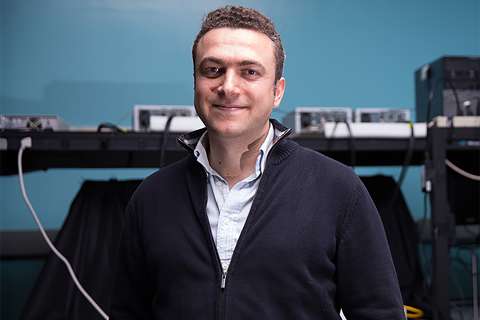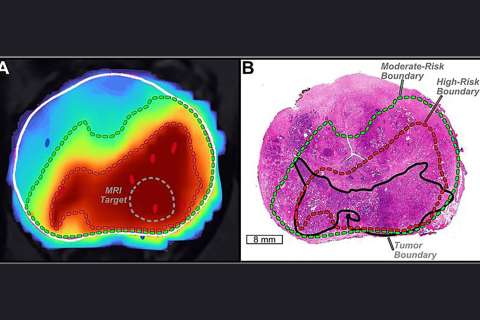It’s nighttime, and you’re lonely or bored, when suddenly you think, “Maybe I should have a snack.”
Or you get a distressing medical diagnosis, and it seems like a cookie or two might help you make sense of the news.
Or your child misbehaves, you got a parking ticket, you’re feeling unsatisfied in your job or relationship, and you just feel like having something to eat.
We’ve learned to associate food with comfort since our earliest days, which is why it can feel so natural to turn to food as a salve even when we’re not physically hungry, said Eve Lahijani, RDN, a dietitian with the Simms/Mann UCLA Center for Integrative Oncology.
“Every time we’re reaching for food to help us soothe, it’s not because we’re stupid or broken or something’s wrong with us,” Lahijani said. “It’s something that has been patterned into our psychology for years and years and years.”
But eating when we’re not physically hungry has consequences: It can cause us to feel bad about ourselves and can make it hard to maintain a healthy weight.
Lahijani offered strategies to deal with what’s often called “emotional eating” during a recent webinar sponsored by the Simms/Mann Center: “How to Conquer the Urge to Eat When You Are Not Physically Hungry.”
Why do we eat when we’re not hungry?
Also known as compulsive eating, or “mouth hunger,” non-physical hunger is common, affecting 38% to 49% of adults in any given month, studies report. The behavior is never arbitrary, Lahijani said: “It’s always for a really good reason,” often a way to deal with emotions we find uncomfortable or unacceptable.
“Anything that happens outside of our emotional equilibrium … could trigger the non-hunger urge to eat,” she said.
Feeling overwhelmed, misunderstood, frustrated or tired can trigger emotional eating. So can fear, emotional pain or physical pain. Even excitement can prompt us to eat. It may just be habit, Lahijani said, such as heading straight for the fridge after getting home from work. We may also eat to calm ourselves when coping with unknowns.
This is relevant to the cancer journey because “there's so many unknowns, there's so many stressors,” said Lahijani. “There are so many moments where you may feel elated or it might be one of the worst moments in your life.”
Dealing with emotional eating
Lahijani suggested three options for dealing with the desire to eat when not physically hungry:
Eat anyway
When the desire to eat arises outside of real hunger, we may choose to eat anyway: “When you use food to cope … it’s because it works,” she said.
Because of our lifelong association with food as a source of comfort, it can soothe us and even lift our mood. But there are disadvantages associated with eating for comfort.
One is that by feeding the issue, we aren’t addressing the underlying emotional causes, which allows them to persist.
Another is the self-recrimination that often accompanies emotional eating, which can further trigger an urge to eat.
Lahijani shared a story about a former client who felt uncomfortable after receiving mixed feedback during her annual performance review. She ate a few cookies. Then she judged herself for eating cookies when she’d been spending time and energy working with a dietitian.
“When she judged herself, it made her feel so horrible that she re-triggered herself,” Lahijani said.
The client went on to eat the whole sleeve of cookies, which made her feel even worse, judge herself more and ultimately finish the whole box.
“This is a really great illustration of why, when we start emotional eating, we don’t stop,” Lahijani said. “Because it’s fueled by this judgment.”
With practice, we can notice the tendency to judge ourselves for eating when we’re not hungry.
“The way you get rid of the judgment is by understanding that you did that for a reason,” Lahijani said, “and by starting to understand and figure out what that reason is.”
Responding to emotional eating with curiosity instead of judgment allows us to see patterns and ultimately identify the feelings underlying the behavior.
Distract yourself
When you notice the urge to eat when you’re not physically hungry, you can choose to distract yourself: take a walk, snuggle with a pet, read a book, watch a video, listen to your favorite song, wash your face, call a friend.
Choose something you enjoy, something that’s easy and accessible, Lahijani said: “If it takes more than 15 minutes or costs more than $15, swipe it off your list.”
Distraction is great when you don’t know what’s triggering you to eat, she added. It’s not advised, however, when you’re actually hungry.
If it’s been several hours since your last meal, you’re likely to be legitimately hungry, rather than eating emotionally, she said. Distraction also “doesn’t work” when your diet is nutritionally deficient, Lahijani said. We all need adequate protein, carbohydrates, fat and fiber. People undergoing cancer treatment may need even more protein. Appetite changes associated with treatment can also be a challenge.
“Eating in a way that isn’t satisfying or pleasurable might actually trigger more emotional eating,” she said.
A healthy plate should be half fruits and vegetables, a quarter protein and a quarter grains or starchy carbohydrates. We also need some fats, such as from avocado, nuts, seeds or fatty fish.
If you’re eating a balanced diet, distraction is “an effective short-term strategy” that can prevent emotional eating and, over time, could make you less likely to use food to process your feelings, Lahijani said.
However, there are potential downsides to the distraction method.
“The disadvantage is that it may further aggravate the issue,” Lahijani said. “Every time you have the urge to eat when you’re not physically hungry, it’s a part of you that’s asking for your attention. If you’re using a distraction … that part of you that wants to be felt or that part of you that wants to be heard gets further frustrated.”
Choosing not to use food to cope with uncomfortable emotions can potentially lead to other compulsive behaviors, such as using substances or gambling in place of food, Lahijani added. And the distraction method doesn’t address the underlying issue that triggered the desire to eat in the first place.
Become aware of the trigger and deal with it directly
“This may be the most challenging option,” Lahijani said. “But I want you to know that this is the most rewarding, can lead to the best and most long-term results and the most fulfilling life, no matter what’s happening in your life.”
Dealing with the trigger “is actually about learning how to feel,” she said.
Most of us weren’t taught how to feel our feelings, she said, thus making us prone to respond by self-soothing or distraction.
Feelings are a sensation in the body. It may be tightness in the chest or jaw, a buzzing feeling in the stomach, tension in the shoulders or neck. It could be a salty taste in the throat or a congestion in the hips.
Lahijani advised using texture, temperature and color to describe the sensation.
“This is what we’re emotionally eating,” she said. “This is what we’re running from … the felt experience of the emotion.
“Most people on the planet run from this,” she added.
After identifying a sensation, the task is to just be with it – to experience it without trying to fix or change it. And to breathe, noticing how the sensation moves or morphs. The feeling may change or dissipate within seconds, she said, or it could take several sessions to feel an emotion completely.
Feelings are like children tugging on their parents’ sleeve to be heard and validated, Lahijani said. Being with the felt sensations or our emotions provides that validation to ourselves.
Whether you choose to self-soothe with food, distract yourself, or bravely feel your feelings, “every time you eat is an opportunity to learn more about yourself,” she said.





